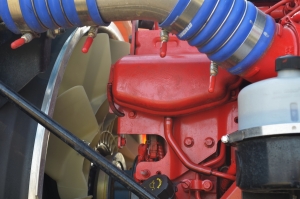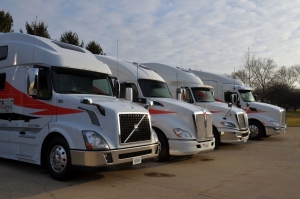Cummins X15 Pt 1: An Overview
 COLUMBUS, IN — As engine platforms go, Cummins’ ISX has to be considered slightly remarkable. It was introduced in 1998, although the program that brought the engine to life began in 1994. It survived the transition to EGR (Exhaust Gas Recirculation) and then to SCR (Selective Catalytic Reduction) aftertreatment. Several other engines did not. And it’s still very much alive and kicking today.
COLUMBUS, IN — As engine platforms go, Cummins’ ISX has to be considered slightly remarkable. It was introduced in 1998, although the program that brought the engine to life began in 1994. It survived the transition to EGR (Exhaust Gas Recirculation) and then to SCR (Selective Catalytic Reduction) aftertreatment. Several other engines did not. And it’s still very much alive and kicking today.
We spent a day test driving a couple of production-intent versions of the 2017 X15 (as it’s now known), and a current ISX15 for comparison.
Coming in 2017 are two distinct versions of the engine — one tuned for fuel economy, the other for performance. Most of the changes are electronic, but Cummins has made some physical changes to the air handling system and reduced internal parasitic drag on both models. In the case of the performance version, Cummins has optimized the combustion hardware and improved what it calls the combustion recipe.
The impact of the enhancements is subtle but noticeable. In plain English, the 2017 models felt peppier, a little quicker, and smoother to respond, and generally had a firmer feel. The engine brake’s performance at very low rpms was quite a surprise, and even more so in the performance version of the engine, which boasts a new and improved version of the venerable Cummins variable geometry turbocharger.
With trends in engine speed drifting lower with each passing year, drivers were becoming dissatisfied with the engine brake’s performance, apparently not realizing (or forgetting) that a simple downshift would restore the massive retarding power available from a 15-liter engine. That downshift is no longer required, but be prepared for a treat if you decide to drop it down a gear.
 Electronically speaking, it’s pretty clear that Cummins and Eaton have been spending a lot of time together in the lab and on the track. The 2017 version of the SmartAdvantage powertrain is as smooth and perfectly integrated as any of the vertically integrated powertrains they compete with. Clutch engagement on the Eaton side is dramatically improved over earlier versions, and slipping between the top two small-step gears was barely noticeable on modest highway grades.
Electronically speaking, it’s pretty clear that Cummins and Eaton have been spending a lot of time together in the lab and on the track. The 2017 version of the SmartAdvantage powertrain is as smooth and perfectly integrated as any of the vertically integrated powertrains they compete with. Clutch engagement on the Eaton side is dramatically improved over earlier versions, and slipping between the top two small-step gears was barely noticeable on modest highway grades.
The close ratio-step between 9th and 10th is meant to keep the engine running close to its fuel-efficient sweet spot as long as possible. Interestingly, the 2016 engine would lug — if we can still use that term (it hardly applies anymore) — down to 1,070 rpm before making a downshift on a grade, whereas the 2017 dipped down to 1,040 before giving up a gear, starting from a cruising rpm between 1,100 and 1,125. If for some reason you aren’t using cruise control, the 2017 version will deliver peak torque all the way down to 975 rpm.
Both of the fuel-efficient versions of the engines I drove had the ADEPT (Advanced Dynamic Efficient Powertrain Technology) technology suite featuring SmartCoast and SmartTorque2 (ST2). The 2017 version also had Cummins own Predictive Cruise Control (PCC) feature, currently available only on Paccar products. Cummins will have its own PCC package for 2017 and it will be available across all truck platforms.
SmartTorque has been around for a few years, but the latest evolution known as ST2 provides additional torque when transmission sensors detect the vehicle is on an uphill grade.
SmartCoast was new in 2016. It disengages the engine from the transmission on modest downgrades for almost drag-free coasting with the engine at idle. Coupled with SmartCruise, customers can set their own droop settings (between five kilometers per hour below, and 10 kilometers per hour above, set cruise speed) for reengagement and engine brake activation on grades, so they can harvest the maximum amount of momentum from a hill.
Previous versions of SmartCoast dropped the engine to a 600-rpm idle, but for 2017, Cummins says it is so confident in the new air handling system’s faster transient response that it is comfortable letting the engine drop to 500 rpm with no worries about rapid re-engagement.
The performance version of the engine I drove did not have ADEPT because it had a manual transmission. ADEPT is designed to work with the SmartAdvantage powertrain only, featuring an Eaton Automated Manual Transmission.
On the road
For each truck, we ran about 65 kilometers south of Cummins’ hometown of Columbus, Indiana on I-65. There were a few modest 2-3% grades en route to get a sense of how it all worked.
The PCC feature was interesting. It has GPS maps loaded into the computer, and with the aid of terrain mapping and inclinometers built into the engine and transmission, PCC looks about three kilometers ahead to get a picture of what’s coming. The PCC manages throttle and gearing based on the terrain, and does a really good job. It would begin roll on a bit of power just ahead of a grade to build up momentum before climbing, and throttle back just as we began to crest the hill to take advantage of gravity on the downside.
It’s nothing more than a pro driver would do, but even the best of us have lapses in attention. We might miss an opportunity or six to conserve a little more fuel. Not PCC.
Before leaving the plant in Columbus, Mario Sanchez-Lara, director of on-highway marketing communications and my tour guide for the day, reset the fuel economy display for a fresh start. Granted, it was a short run, but we saw the average fuel economy trending upward throughout the run. It went from 6.6 miles per gallon (35.6 liters per 100 kilometers) to 7.7 (30.5) with the 2017 engine, and from 6.1 (38.5) to 7.2 (32.6) with the 2016 engine when we returned to the plant.
In real-world reporting on a round trip from the Cummins Engine Plant in Columbus to the Jamestown, New York plant, the 2017 engine logged an average of 8.4 miles per gallon (28 liters per 100 kilometers) with an average road speed of 87 kilometers per hour pulling a trailer loaded to a 66,000-pound Gross Vehicle Weight. It also had 213 SmartCoast events on the trip, where the engine was disengaged from the transmission and the truck was coasting for free.
My feeling, after a day out with the two generations of engine, is that Cummins has made a good thing better. Even with the automated transmission and a lack of direct involvement in operating the engine and transmission, that peppy and tight feeling was obvious. It’s just a nicer-running version of the current ISX15.
I have always been inclined to let an engine drift into the lower end of the rpm range to take advantage of the torque down there, but various older Cummins and Eaton products didn’t always cooperate. They are now completely over their aversion to low-rpm operation, and the two – better described as “one” under the SmartAdvantage banner — handle it very well.
I’ll save my report on the performance engine for a future feature, but I would say that engine had all the performance attributes of the fuel efficient version, but with 605 horsepower and 1,850 lb ft of torque to play with. Sweet!
The rating of the 2016 ISX15 engine and the 2017 X15 engine were the same: 450 horsepower with ST2 1,550/1,750 lb ft. The 2017 engine enters limited production in October, with full production slated to begin in January.


Have your say
This is a moderated forum. Comments will no longer be published unless they are accompanied by a first and last name and a verifiable email address. (Today's Trucking will not publish or share the email address.) Profane language and content deemed to be libelous, racist, or threatening in nature will not be published under any circumstances.